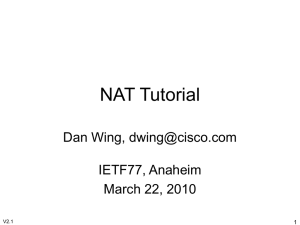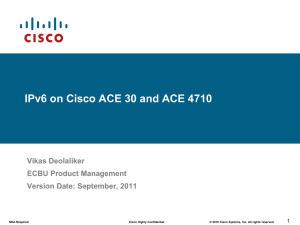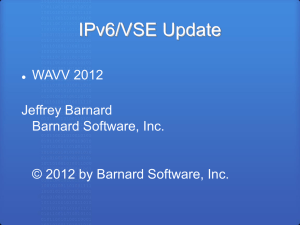4V6 – stateless 4Via6
advertisement
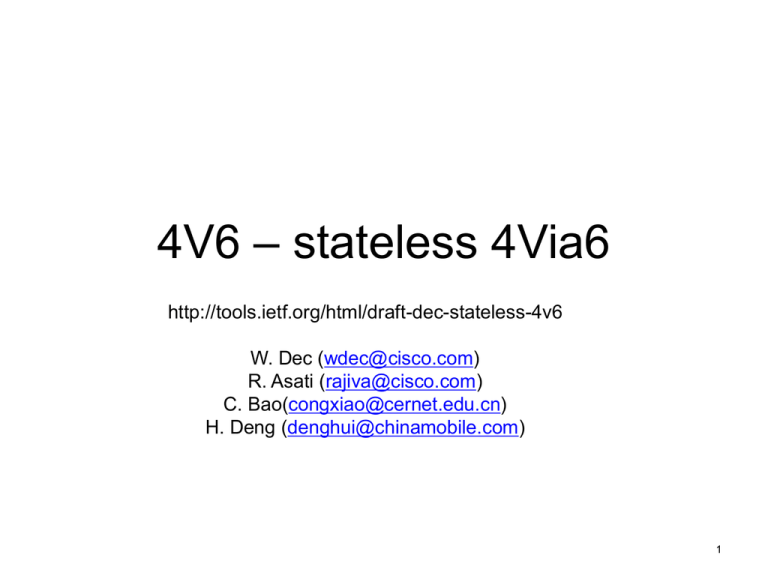
4V6 – stateless 4Via6 http://tools.ietf.org/html/draft-dec-stateless-4v6 W. Dec (wdec@cisco.com) R. Asati (rajiva@cisco.com) C. Bao(congxiao@cernet.edu.cn) H. Deng (denghui@chinamobile.com) 1 Introduction • Motivation for stateless solutions can be found in: draftoperators-softwire-stateless-4v6-motivation • A number of stateless solutions have been proposed. – 4rd, 4v6 (encapsulated or translated mode) – dIVI-PD (translated mode) • These stateless solutions have shared characteristics; commonly termed stateless 4V6. – Main differences lies in algorithm and form of transport: v4-v6 Mapped-Encapsulation or v4-v6 Translation • This presentation focuses on the operational considerations of Stateless4V6 and its forms of transport • It also looks at the 4V6 impact when applied to wider industry standard architectures 2 4V6 IPv6 Address • CE IPv6 subnet is assigned announced via DHCPv6-PD or RA (/64) – This is NOT in addition to another PD or RA prefix • 4V6 index encodes all or part of the IPv4 address + a port index. 3 Stateless 4V6 Translation Mode (example only – NOT numerically accurate) NAT44 +4V6 IPv4-Private Customer + IPv6 NAT Index - f = Ports 2000-2999 4V6 address= 2001:beef:(1.1.1.1. f):: NAT44 Source IP Address + Port DA:port SA:port Done by CPE 2001:beef:: IPv6 8.8.8.8:80 192.168.0.1:1444 8.8.8.8:80 4V6 Gateway IPv4-Public Stateless v4-v6 address mapping 1.1.1.1:2000 Stateless NAT64 DA:port 2001:beef:8.8.8.8:80 SA:port 2001:beef:1.1.1.1.f:2000 8.8.8.8:80 Done by GW Stateless IPv6 to IPv4 mapping (NAT64) + port index DA:port SA:port 2001:beef:1.1.1.1.f:2000 NAPT Done by CPE 1.1.1.1:2000 192.168.0.1:1444 1.1.1.1:2000 8.8.8.8:80 8.8.8.8:80 2001:beef:8.8.8.8:80 User’s native IPv6 traffic not shown – travels as ships in the night using native IPv6 forwarding 1.1.1.1:2000 8.8.8.8:80 Stateless46 Mapped Tunnel Mode – (Example only - NOT numerically Index -accurate) f = Ports NAPT44 +4V6 IPv4-Private Customer + IPv6 NAT 2001:beef::ff 4V6 address = 2001:beef:(1.1.1.1 .f): NAPT Source IP Address DA:port SA:port Done by CPE 2000-2999 8.8.8.8:80 192.168.0.1:1444 8.8.8.8:80 Note: IPv4 Port shown for IPv4 packets IPv6 MAP IPv4 to IPv6 address + Encap. DA=4rd Gateway Address 1.1.1.1:2000 DA 2001:100 4V6 Gateway SA 2001:beef:1.1.1.1.f 8.8.8.8:80 IPv4-Public Decap packet 1.1.1.1:2000 8.8.8.8:80 Done by GW MAP IPv4 to IPv6 address + index & Encap 2001:beef:1.1.1.1.f NAPT Done by CPE 1.1.1.1:2000 192.168.0.1:1444 8.8.8.8:80 8.8.8.8:80 1.1.1.1:2000 2001:100 1.1.1.1:2000 8.8.8.8:80 User’s native IPv6 traffic not shown – travels as ships in the night using native IPv6 Decap Packet forwarding 1.1.1.1:2000 8.8.8.8:80 Stateless 46 Comparison Summary 4V6 Mapped Tunnel Mode 4V6 Translation Mode Base technology Port restricted NAPT44 + IPv4 in IPv6 mapped encapsulation. Port restricted NAPT44 + modified stateless NAT64 Transport non-UDP/TCP traffic? No No Location of NAPT44 function CPE CPE IPv4 Forwarding paradigm at relay L3 + L4 lookup L3 + L4 Lookup IPv6 addressing constraints Prefix distributed via regular DHCPv6-PD Prefix distributed via regular DHCPv6or SLAAC. NO ADDITIONAL Prefix PD or SLAAC. NO ADDITIONAL Prefix required. required. IPv4 addressing constraints Sharing fixed per IPv4 subnet/domain Sharing fixed per IPv4 subnet/domain Overhead in relation to payload of a) a) 4.36% b) 1.71% 550 bytes b) 1400 bytes a) 0% b) 0% ICMPv4 NAT/Markup needed Yes Yes IPv4 Checksum recalculation required Yes - with ICMPv4 support Yes Operation and Provisioning Extensions (DHCPv6, maybe SLAAC, TR69) (DHCPv6, maybe SLAAC, TR69) Supports IPv4 Options Yes No Supports non-shared IPv4 usage/assignment Yes Yes • Operation 4V6 in a 3GPP system 3GPP system functionality is defined to support an extensive set of IP network service requirements, – • • • • Eg Per subscriber QoS, charging, data volume plans. System is in common deployment. IPv6 fully supported in Release 8/9 Key functionality is the representation and signaling across various interfaces of the user’s virtual connection (Bearer). This is specified in terms of IP Filters. 3GPP currently defines IPv4 & IPv6 traffic filters. No clearly defined way how to represent IPv4inIPv6 traffic *alongside* regular IPv6 traffic. – Possible options are an additional (default) bearer (ie additional session), or a new bearer type. 7 Operation 4V6 in 3GPP 4V6 Mapped Tunnel Mode 4V6 Translation Mode Characteristics Summary User Data Plane at PDN-Gw IPv4 over IPv6 over GTP-U over UDP over IP IPv6 over GTP-U over UDP over IP Gx (Diameter) Impacted: v4 over v6 in TFT Filter and Flow descriptors No visible impact Rx (diameter) Impacted: Expressing v4 over v6 Flows No visible impact S5 (GTP) Impacted if new Bearer type is defined No visible impact Additional bearer Possibly required Not required PDN-Gw New TFT capability, IP Gate functionality + changes to Gx and any S5/S7 interfaces No impact SGw No visible impact (except when new bearer is used) No impact Impacted for both IPv6 and IPv4-only applications No impact for IPv6 applications. Feature to map IPv4-IPv6 addresses needed only for IPv4-only applications Flow based applications impacted No visible impact. UE 4V6 CPE 4V6 CPE LTE-Uu Likely changes required if signalling new bearer type No visible impact Lawful Intercept New rules for tunnel support PCRF AF No visible impact Operation 4V6 in a PCMM system • Cable Labs 9 Pkt-mm-1 Operation 4V6 in PCMM 4V6 Translation Mode 4V6 Mapped Tunnel Mode Characteristics Summary Impacted. Needs new flow Pkt-mm-2 (COPS) definition Impacted. Needs extension to support IPiniP flows No impact No impact Pkt-mm-3 (COPS) Impacted. Needs extension to support IPiniP flows No impact eRouter/CPE Requires 4V6 support Requires 4V6 support CMTS Impacted. Needs extension to support IPiniP flows No impact Policy Server Impacted. Needs extension to support IPiniP No impact Application Manager Impacted. Needs extension to support IPiniP No impact for IPv6 applications. IPv4 only applications require feature Conclusion No critical technical issues with 4V6 and either the 4V6 mapped-tunnel or translation based modes Both approaches represent valid choices Translated (non encapsulated) transport appears to be operationally less impactful to broader systems and services Re-uses native IPv6 network features and system interfaces Does not require numerous IPv4 extensions to standard architectures that already support IPv6 Operational impact of both approaches should be documented and trade-offs outlined/clarified. 11

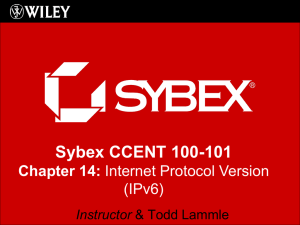

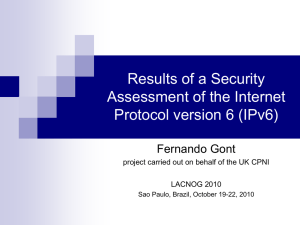



![IPv6[1]](http://s2.studylib.net/store/data/005281349_1-180d2db5384c16fc00944abde40d10a1-300x300.png)

